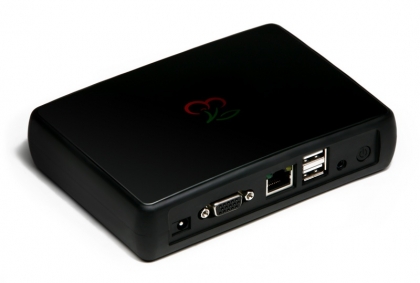A new personal computer company called CherryPal is betting that many PC users will be willing to change their concept of what a home or institutional PC should provide, how it works and what it looks like. The company is set to launch their initial PC desktop product, the CherryPal C100, with shipments expected to start at the end of July.
This remarkably compact PC is the size of a paperback book and, according to the company’s Web site, contains 80% fewer components than a typical desktop while consuming less than 2 watts of power, which the company claims is 98% less than a comparable desktop.
Let’s take a closer look at the power consumption reduction potential. According to the Energy Star energy calculator, a typical ‘value’ desktop PC with 100 watt power supply consumes 165.3 kWh/yr (assumes a home ‘power user’ with four hours of active use per day). In comparison, the CherryPal would consume a mere 3.3 kWh/yr. Doing the math, indeed, this is 98% less energy. What about other sustainability benefits? Certainly, 80% fewer components means less raw material consumed, assuming the remaining 20% aren’t made of ‘super toxic’ materials, again a big plus. The smaller size/lower weight also translates to reduced packaging, logistics and end-of-life impacts.
The CherryPal could be considered revolutionary since it challenges current concepts of what a PC is and how it works. Key features:
- uses a low power processor from Freescale
- uses a 4GB NAND flash-based solid state drive
- runs a version of Linux OS, although the user cannot access or change it
- does not include a magnetic media disk drive or optical drive
- includes 50 GB of storage in the ‘cloud’ (increased remote storage capacity available in the future)
- users cannot load their own software locally; all application software is provided through the cloud (which means you need a broadband connection), and at launch includes iTunes, OpenOffice, instant messenging and a media player with more apps to be added
- Mozilla Firefox is included and is the fundamental UI
- I/O is similar to a standard PC, with connections for a VGA monitor, two USB ports, and an audio output
- WiFi 802.11b/g and 10/100 ethernet port included
So, obviously, this is not the PC solution for everyone. If you need to be able to add specific hardware cards or load additional third party software, it’s not for you. If you have to have Windows Vista (right), it’s not for you. But for the millions of users who use their PCs primarily for Web surfing, iTunes and the occasional document, spreadsheet or presentation (and don’t need MS products), it is viable. If you need local storage for music, pictures or other data, add a USB hard drive or an optical drive. Of course, adding peripherals increases the power consumption, but at least you can turn them off when not needed. Yes, the data and app servers in the cloud require energy, but at least this is a shared resource.
So, the bottom line is that there would be a significant overall reduction in environmental impact. The question is: can you live with the changes? In my case, I use my home PC for many more things (music recording is one) that would preclude my use of a CherryPal. However, I can think of at least three people in my immediate family who would be served very well by its capabilities.
Oh, did I mention that the list price is $249?
http://www.cherrypal.com/
http://www.eu-energystar.org/en/en_007c.shtml
Image: CherryPal
Image Credit: © CherryPal

